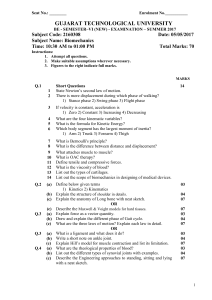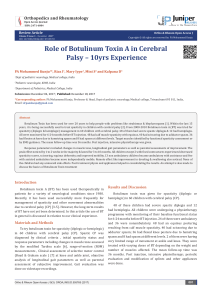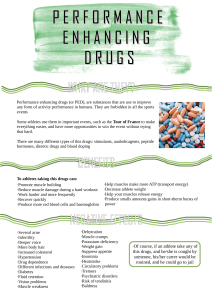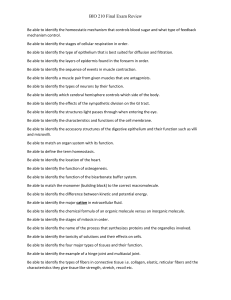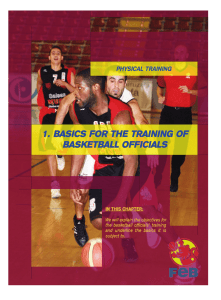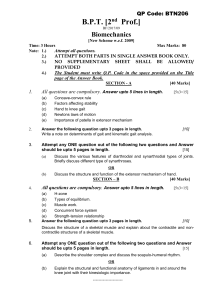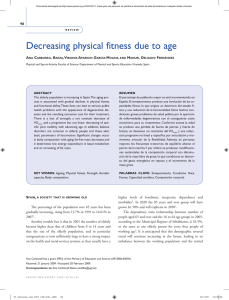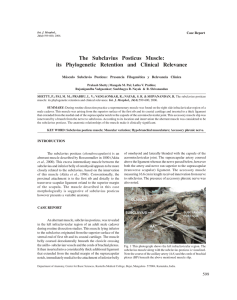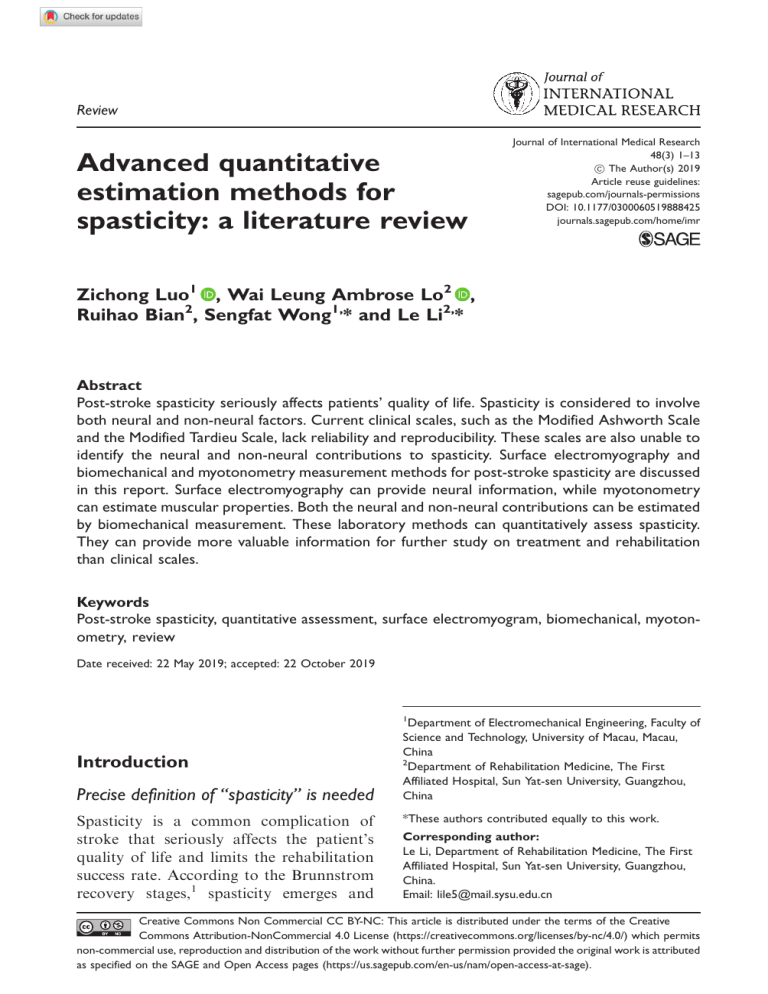
Review Advanced quantitative estimation methods for spasticity: a literature review Journal of International Medical Research 48(3) 1–13 ! The Author(s) 2019 Article reuse guidelines: sagepub.com/journals-permissions DOI: 10.1177/0300060519888425 journals.sagepub.com/home/imr Zichong Luo1 , Wai Leung Ambrose Lo2 , Ruihao Bian2, Sengfat Wong1,* and Le Li2,* Abstract Post-stroke spasticity seriously affects patients’ quality of life. Spasticity is considered to involve both neural and non-neural factors. Current clinical scales, such as the Modified Ashworth Scale and the Modified Tardieu Scale, lack reliability and reproducibility. These scales are also unable to identify the neural and non-neural contributions to spasticity. Surface electromyography and biomechanical and myotonometry measurement methods for post-stroke spasticity are discussed in this report. Surface electromyography can provide neural information, while myotonometry can estimate muscular properties. Both the neural and non-neural contributions can be estimated by biomechanical measurement. These laboratory methods can quantitatively assess spasticity. They can provide more valuable information for further study on treatment and rehabilitation than clinical scales. Keywords Post-stroke spasticity, quantitative assessment, surface electromyogram, biomechanical, myotonometry, review Date received: 22 May 2019; accepted: 22 October 2019 1 Introduction Precise definition of “spasticity” is needed Spasticity is a common complication of stroke that seriously affects the patient’s quality of life and limits the rehabilitation success rate. According to the Brunnstrom recovery stages,1 spasticity emerges and Department of Electromechanical Engineering, Faculty of Science and Technology, University of Macau, Macau, China 2 Department of Rehabilitation Medicine, The First Affiliated Hospital, Sun Yat-sen University, Guangzhou, China *These authors contributed equally to this work. Corresponding author: Le Li, Department of Rehabilitation Medicine, The First Affiliated Hospital, Sun Yat-sen University, Guangzhou, China. Email: [email protected] Creative Commons Non Commercial CC BY-NC: This article is distributed under the terms of the Creative Commons Attribution-NonCommercial 4.0 License (https://creativecommons.org/licenses/by-nc/4.0/) which permits non-commercial use, reproduction and distribution of the work without further permission provided the original work is attributed as specified on the SAGE and Open Access pages (https://us.sagepub.com/en-us/nam/open-access-at-sage). 2 resolves along with the motor recovery process, which begins immediately after stroke onset. Other scholars2,3 have described spasticity as a component of upper motor neuron syndrome, which is composed of positive and negative symptoms. The positive symptoms include excessive muscle tone, stretch reflex, clonus, and spasms. The negative symptoms include incoordination, fatigue, weakness, and impaired motor control, which are functionally disabling and probably resistant to treatment. Spasticity is easily described and recognized clinically, but understanding and accurately defining spasticity are much more complicated. Establishment of a formal definition of spasticity has been ongoing for several decades. Lance4 proposed the most accepted and commonly cited definition of spasticity in 1980. He concluded that spasticity is a motor disorder characterized by a velocity-dependent increase in muscle tone with exaggerated tendon jerk resulting from hyperexcitability of the stretch reflex as one component of upper motor neuron syndrome. In 1994, based on Lance’s4 work, Young5 added the micro-concept of “abnormal intraspinal processing of primary afferent input” to the definition of spasticity. A more recent definition proposed by Pandyan et al.2 in 2005 was an update of the definition established by Lance4 and redefined spasticity as “disordered sensorimotor control resulting from an upper motor neuron lesion, presenting as intermittent or sustained involuntary activation of muscles.” However, poststroke spasticity shows tremendous variability and usually does not fully conform to any of these definitions.6 The pathophysiology of post-stroke spasticity explains its variability. Spasticity originates from plastic rearrangement in the central nervous system. Abnormal intraspinal processing caused by the imbalance of inhibitory and excitatory tracts in the spinal network is emphasized in other published Journal of International Medical Research studies.7–11 Reticulospinal hyperexcitability is considered to be the mechanism underlying the development of post-stroke spasticity.3 A recent study highlighted the importance of ipsilateral premotor and supplementary motor area cortico-reticulospinal tract hyperexcitability related to disinhibition after stroke.12 The location of an upper motor neuron syndrome lesion can determine the characteristics of the spasticity. Injuries in a particular area may result in different symptoms in different patients, indicating the sophistication of spasticity. Typical features of post-stroke spasticity, such as hypertonia, paresis, and muscle spasms, are attributed to the underlying neural mechanisms. However, spasticity cannot be regarded as the sole consequence of the neural mechanism or central neural system injury.13 Non-neural mechanisms can also have secondary effects that contribute to the clinical symptoms of increased muscle stiffness and muscle fatigue. Paresis can cause a decrease in the daily turnover of the extracellular matrix. This leads to increased viscosity of hyaluronan, which causes decreased gliding of collagen fiber layers and presents as increased muscle stiffness.14 Although muscle fibers are the primary focus in post-stroke spasticity, there is no agreement on the role of muscle fiber pathology and hyperexcitability or abnormal muscle activity in the spasticity process.14,15 Thus, the difficulty in defining spasticity is that impairment may change with the process of motor recovery, and multiple impairments may be present simultaneously. A precise or universal definition of poststroke spasticity has not been proposed, reflecting the intrinsic nature of spasticity as a multi-factor entity.6 Nevertheless, spasticity is commonly understood to be composed of both neural and non-neural (peripheral) contributions. Newly developed measurements of spasticity should be based on this understanding. Luo et al. Quantitative measurement of spasticity Spasticity is simple to observe clinically but difficult to quantify because of the involvement of multiple elements that contribute to spasticity. Tools with which to objectively estimate and measure spasticity are essential. Various methods to measure spasticity are currently available. Commonly used tools are subjective clinical scales, including the Ashworth Scale (AS),16 the Modified AS (MAS),17 the Tardieu Scale (TS),18 the Modified TS (MTS),19 the Tone Assessment Scale (TAS),20 and the Ankle Plantar Flexors Tone Scale (APTS).21 The AS was developed to measure spasticity by detecting hypertonicity in patients with multiple sclerosis, and the MAS was designed to measure muscle tone by rotating a joint and estimating the resistance. When examiners perform the AS test, the patient’s joints are passively moved through the full range of motion. The examiner then judges the level of resistive tone on the AS, with the score ranging from 0 to 4. A score of 0 indicates no increase in tone, and a score of 4 signifies that the affected part is rigid in flexion or extension. For the MAS test, an additional score (1þ) and its description are added to enhance the sensitivity of the scale. However, Ansari et al.22 raised further questions regarding the inter-rater reliability of both the AS and the MAS. They proposed the Modified Modified Ashworth ScaleMAS (MMAS) instead, which removes the grade of “1þ” and redefines the grade as “2.” The MMAS reportedly has better inter-rater reliability in different spastic muscle groups.23 The TS is suggested to be an alternative to the AS for use in muscle spasticity measurement.24–26 The TS has an advantage over the AS and MAS because velocity is incorporated into the assessment.27 The MTS is an updated version of the TS and addresses the intensity of the resistance, first-noticed catch angle, clonus, and differences among 3 joints and muscles that move at different velocities.27 Both the TAS and the APTS are multi-item scales. The TAS is composed of three sections: the resting posture, the response to passive movement as assessed by the MAS, and the movement in response to active efforts.20,28 The APTS also consists of three sub-tests: the passive resistance of the plantar flexors from the point of maximum dorsiflexion to maximum plantar flexion, the resistance at the middle range of plantar flexion, and the resistance at the final range of plantar flexion. The sub-test score ranges from 0 to 4. The stretch reflex sub-test has been shown to be significantly correlated with the TS and MAS.21,28 Clinical scales have no instrumental requirement; they can only classify subjective information. Most of these scales have the main limitation of reliability and interexaminer reproducibility. Many uncontrollable or unstable factors may affect the measurement results. The duration of passive joint movement during the test procedure is not specified, although one study suggested that this duration should be 1 second.29 Repetitive passive range of motion will decrease the resistance, which might affect the AS and MAS scores.30 Some studies have revealed the inter-rater reliability of these scales. Haas et al.31 found that raters preferred to use scores on the lower end of the scale and that the inter-rater reliability varied among the tested muscle groups. Lechner et al.32 found that the correlation between the patient self-reported spasticity rating and clinical measurement with the AS was weak in three of eight subjects, and no correlation was found in the remaining five subjects. The potential problems of the MTS are that interpreting reliance on clonus is difficult at the higher ends of tones and that clonus can worsen after an intervention.33 Besides the limited reliability and reproducibility, discrimination between neural 4 and non-neural causes of spasticity is impossible. These problems are concerning to researchers and physiotherapists because they make it difficult to understand the individual patient’s present condition and evaluate different intervention strategies. Researchers and engineers have applied technical advances to obtain objective data for the quantitative measurement and study of spasticity. They have used devices to measure stiffness, muscle tone, angular velocity, and muscle electrical activities. One published review described these methods, which may provide reliable quantitative objective information regarding muscle spasticity for purely clinical purposes.34 Different from the previous literature review, the present article discusses several advanced quantitative post-stroke spasticity measurement methods (summarized in Table 1) that are practicable for both research purposes and patient evaluation in the clinical setting. We herein discuss the potential requirements for the development of more appropriate measurement methods to monitor spasticity. Quantification of neural contribution Post-stroke spasticity is considered a positive sign of upper motor neuron syndrome, reflecting the muscle tone and stretch reflex. Monitoring muscle neural activities is a meaningful way to assess or quantify spasticity. Electrophysiological measurement Electrophysiological assessment, such as measurement of the reflex activities of the H-reflex and F-waves, can be used for objective evaluation of post-stroke spasticity.35 The H-reflex (i.e., Hoffman reflex) is a late response triggered by stimulation of the sciatic nerve at an incremental frequency that stimulates the primary afferent fibers and motor neurons.29 The generation of Journal of International Medical Research F-waves is another late response conducted along the peripheral nerves. F-waves are triggered by supramaximal electrical stimulation of mixed nerves while recording the distal muscles innervated by the nerves. The M-response is the maximal electrical stimulation of the peripheral nerves that leads to the development of a compound motor action potential, which can be recorded on the muscles innervated by the stimulated nerve. The H/M or F/M ratio measures the underlying physiology associated with post-stroke spasticity.36 The ratio should be within a specific range for healthy individuals and is higher when spasticity is present. Single-channel surface electromyography (sEMG) is a noninvasive, convenient, and low-cost method to record the muscle activity intensity and activity pattern in patients with post-stroke spasticity. This technique has the potential for extensive use in the clinical setting. Researchers have developed several applicable methods with which to quantitatively estimate post-stroke spasticity based on single-channel sEMG measurement. Because of the loss of normal muscular motor control, co-contraction of antagonist muscles is recognized as a clinical phenomenon in post-stroke survivors. This symptom can be confirmed and quantified by a group of sEMG sensors attached to the particular muscle and its antagonistic muscle. Classically, the calculation of the cocontraction index (CI) required subtraction of the average resting EMG activity and normalization to the maximum value of EMG activation in each muscle during the maximum voluntary contraction (MVC) tests. The CI ranges from 0 (no overlap of the two EMG envelopes) to 1 (the two muscles are fully activated to 100% MVC during the trial). Another similar sEMG-based index (the A-ApA) with which to measure spasticity was proposed by Wang et al.37 in 2017. This index is similar to the sEMG Luo et al. 5 Table 1. Summary of literature on methods for post-stroke spasticity assessment. Methods Concern Subjective /objective Selected references Clinical scales Ashworth Scale Modified Ashworth Scale Mixed Mixed Subjective Subjective Mixed Mixed Mixed Mixed Mixed Subjective Subjective Subjective Subjective Subjective Ashworth16 Bohannon and Smith17 Naghdi et al.23 Tardieu et al.18 Boyd and Graham19 Gregson et al.20 Takeuchi et al.21 Objective Objective Objective Objective Objective Çakır et al.35 Sun et al.38 Yao et al.40 Bohannon44 Platz et al.46 Objective Lindberg et al.48 Objective Objective Lo et al.60 Brandenburg et al.52 Modified Modified Ashworth Scale Tardieu Scale Modified Tardieu Scale Tone Assessment Scale Ankle Plantar Flexors Tone Scale Neural contribution measurements H-reflex and F-wave Single-channel sEMG High-density sEMG Pendulum test Resistance to passive movement Peripheral contribution measurements NeuroFlexor Myotonometer Sonoelastography Neural Neural Neural Neural Neural contribution contribution contribution contribution contribution Neural and peripheral contributions Peripheral contribution Peripheral contribution “Mixed” denotes that the spasticity measurement method cannot distinguish neural versus non-neural contributions. signal recorded from the biceps and triceps during passive extension and flexion movement of the elbow. Using this newly proposed index, Wang et al.37 assessed spasticity in the upper limbs of patients with hemiplegia. The results showed a clear negative correlation between the recommended index and the patients’ MAS score. This method provides a potential quantitative scale to estimate spasticity with a reduction in individual differences. Besides the CI, other information can also be obtained via sEMG devices. Research on sEMG signal entropy has been gaining popularity in recent years. The value of sEMG entropy provides quantitative information about the complexity of the signal data. It relates to the number and firing rate of active motor units during the test. The entropy calculation is controlled by several parameters. Generally, the entropy result is presented as a loop of a parameter; the other parameters are fixed. The reason for this is to reduce the chance of creating an abnormal, singular point result in a particular input. Sun et al.38 applied fuzzy approximate entropy (fApEn) to investigate the sEMG segment collected from the affected triceps of poststroke subjects during MVC with robotaided rehabilitation training. The result showed that the correlation between fApEn values and MVC was significant, suggesting that the entropy method was valid. Although a significant difference in fApEn was found between the paretic and non-paretic side, the value was not comparable among individuals and should only be used to compare the change in muscle spasticity within an individual. Single-channel sEMG can applied to evaluate the tonic stretch reflex threshold (TSRT), which is used to assess the neurological aspects of the pathophysiology of 6 spasticity. In TSRT measurement, the angular velocity and joint angle are measured with an electrogoniometer, and the onset of the muscle contraction is monitored by sEMG. This information is obtained in each stretch to calculate the TSRT. Measurement of the TSRT is used to assess the excitability of motor neurons caused by supraspinal and segmental effects, as indicated by the joint angles of motor neurons and their joint muscles during muscle contraction and stretching.39 High-density sEMG, or linear electrode array sEMG, can be used to collect a multichannel signal in a single muscle and thus obtain more valuable information. The muscle fiber conduction velocity (MFCV) can be calculated in the multichannel sEMG device. EMG power spectral analysis has been widely used in neuromuscular studies. Yao et al.40 used high-density sEMG to observe spectrum differences between paretic and contralateral muscles. Their main finding was that the median frequency and the mean power frequency (MPF) of the sEMG signal were smaller on the paretic side than the unaffected side and that the MFCV was significantly slower on the paretic side than the contralateral side. They also found a significant positive correlation between the median frequency and the MFCV. The reduction of the MPF and MFCV on the paretic side may be explained by selective degeneration of the larger motor units.40,41 The decreased motor unit firing rate is considered to be another factor that affects the reduction in the MPF and MFCV on the paretic side. The structure of high-density sEMG devices provides a unique measuring dimension, the MFCV, in the assessment of post-stroke spasticity. This analysis technique is not complicated, but the price of the device may limit its extensive clinical promotion. Various standardized procedures of sEMG measurement are used to quantify the neural contribution to post-stroke Journal of International Medical Research spasticity. Most of these methods are easy to perform because the operator only needs to attach the sEMG sensor and perform the MVC test. However, the result of sEMG measurement may not be available immediately after completing the test. The raw data must be segmented and processed to calculate the result. A solution to this is to use intelligent semi-automatic or fully automatic sEMG signal processing software for clinical use. Notably, although sEMG is still widely applied in laboratory experiments to estimate the patient’s muscle neural activities, the use of sEMG measurement to determine the neural contribution to spasticity remains controversial. Some studies have revealed that fatty tissue infiltration may reduce the spectrum frequency of muscle on the paretic side.42 Therefore, it is difficult to differentiate whether neural activities or tissue alterations affect sEMG signals. Biomechanical measurement A classic biomechanical method can be used to objectively quantify spasticity by measuring and calculating the resistance from passive joint movement; an example is the pendulum test. Generally, isokinetic dynamometers are applied to evaluate the swing of the limb.43–45 The movement angle of the spastic limb is smaller than that of the non-spastic limb. These biomechanical methods do not readily indicate whether neural factors or non-neural factors, such as alterations in muscular viscoelastic properties, dampen the swing movement. Measures of resistance to passive movement (RTPM) may provide a solution to these problems. The RTPM is measured when the patient remains passive throughout the test.46 Passive movement and muscle tone scales (the AS and TS) are included in the test. Torque, stiffness ,and viscosity are often assessed as quantifiable correlates.36 Another robotic device, an exoskeleton Luo et al. known as the NEUROExos Elbow Module (BioRobotics Institute, Scuola Superiore Sant’Anna, Pontedera, Italy), can track the RTPM and active motion tasking. The effectiveness of interventions during rehabilitation treatment can be objectively measured by this device.47 An advanced custom-built apparatus known as the NeuroFlexor48 (Aggro MedTech AB, Solna, Sweden) was developed to estimate the neural and nonneural components separately. During the measurement, slow and fast controlled passive isokinetic wrist extensions are produced to move the subject’s wrist. A force sensor is placed under the palm platform to record the resistance produced during the passive stretch movement. The signal and resistance data are calculated and analyzed by a computational biomechanical model. The neural model output of this model is the neural component (NC) value, which is the difference in force between fast and slow steady movement resistance. The underlying assumption of the NeuroFlexor method is that the decrease in neural resistance is negligible during slow passive movement. The force data collected from the platform sensor are the neural resistance, elasticity, viscosity, inertia force, and gravity, which are then summed. The NC value is estimated by the differences in the maximum extension during passive movement and the sum of the elasticity component (EC) and viscosity component (VC). In a healthy person, the mean estimated NC value is 0.8 0.9 N.49 The NC value reflects the intensity of neural stretch resistance produced from the forearm. Quantification of peripheral contribution The peripheral contribution or mechanical properties of a muscle can be directly estimated using parameters such as stiffness or 7 elasticity, which directly reflect the current muscle situation. The peripheral contribution can also be measured using indirect muscular parameters such as force and torque. Indirect measurement The NeuroFlexor device can provide nonneural (i.e., peripheral) outputs. The EC and VC, which are the non-neural components of muscle spasticity, can be estimated during slow movement (recommended at 5 /s) and fast movement (236 /s), respectively.49 The EC and VC are also force data collected from the same press sensor under the platform of the NeuroFlexor device. Elasticity is a length-dependent resistance that increases as muscles and tendons are stretched. Therefore, a high EC value reflects a decrease in the elasticity of the stretched tissue. Viscosity is the force generated by friction from peripheral tissues. The VC value depends on the velocity of muscle stretching; it peaks during the initial acceleration and remains at a lower level during the subsequent muscle stretching. This method uses the intensity of force to describe the mechanical properties of muscle. In a healthy person, the mean EC and VC values are 2.7 1.1 and 0.3 0.3 N, respectively.49 Thus, these values are indirect measurements compared with other methods that are used to directly measure and describe muscle properties. The biomechanical method using the NeuroFlexor device provides a comprehensive solution for spasticity measurement among the above-described devices and methods. Some studies were performed by the developers of the NeuroFlexor, who claimed that the NeuroFlexor model allows valid measurement of upper limb spasticity and can separate the NC from the EC and VC.48,49 G€averth et al.50 found that the sensitivity of the NeuroFlexor device was adequate for detection of alterations of 8 spasticity after treatment with botulinum toxin type A. Besides direct testing, the biomechanical model can also be used to verify the NeuroFlexor method. Wang et al.51 successfully applied a forward neuromusculoskeletal model to combine all estimated torques. The torque provided by the neuromusculoskeletal model matches the torque measured by the platform force sensor in the NeuroFlexor device. These findings indicate that the NC, EC, and VC values are not meaningless numbers; instead, partial correspondence can be found in the physical world outside of the biomechanical model. Nevertheless, the clinical understanding and significance of these components and the measured resistance torque related to neural or non-neural factors remain unclear. Direct measurement Shear-wave elastography (SWE) uses ultrafast ultrasound imaging to track the propagation of shear waves in muscle tissue, and shear waves propagate faster through enhanced tissue. This is a new approach with which to provide real-time quantitative indicators of tissue material properties. SWE has shown significant correlations with passive muscle stiffness in animal models and healthy subjects.52–54 In another study, SWE and EMG were used to estimate individual muscle strength in healthy subjects, and a significant linear correlation was found between shear modulus and muscle strength.55 These findings suggest that SWE may be a viable method for quantifying the intrinsic strain–stress behavior of muscles after neuromuscular disease. The myotonometer is a tool used to objectively assess muscle stiffness. A handheld myotonometry device is designed for use in the clinical environment. The principle of myotonometry is the application of multiple short impulses to the muscle bulk through the testing probe of the device. Journal of International Medical Research The impulses cause tissue displacement and oscillation in the muscle, and relative information is recorded by an acceleration transducer within the myotonometry device. Several parameters are derived: tone, decrement, stiffness, and creep. One study confirmed significant differences in the muscle properties obtained by myotonometry measurement between a group of patients with chronic stroke and a group of healthy individuals.56 The validity of myotonometric measurements have been tested in some studies. Myotonometric measurements conducted on large muscle groups (hamstring, thigh, and shank) were challenged for their poor discriminant ability.57,58 However, for small muscle groups (relaxed extensor digitorum, flexor carpi radialis, and flexor carpi ulnaris), myotonometry is still a reliable, valid, and responsive measurement method for assessment of the mechanical properties of muscle after stroke rehabilitation.39,59 A previous study demonstrated acceptable relative and absolute inter-rater reliability of myotonometry, which was used to measure muscle parameters in patients with acute stroke in a ward setting.60 All of these findings show that myotonometry devices may be more useful and accurate for measurement of muscle properties than subjective scales. Myotonometry measurement provides a more convenient and less expensive way to assess muscular mechanical properties when compared with other methods, such as ultrasonography and sonoelastography. Although myotonometry has theoretical technical advantages with respect to measurement of muscle properties, its high environmental sensitivity may influence its performance. Current findings show that the reliability of myotonometry may vary from the laboratory setting to the ward setting.60,61 Moreover, studies have shown that the reliability of myotonometry devices may be affected by the operator’s experience and technique.62,63 A standardized Luo et al. operating procedure is required to enhance the reliability of myotonometry measurement. Perspective of spasticity evaluation Post-stroke spasticity has different manifestations at different stages over time, and the proportion of neural and non-neural contributions may vary in each phase. Further analysis of the relative contributions of neural and non-neural components using the aforementioned methods at different stages of stroke can contribute to more personalized rehabilitation programs. Clinically, botulinum toxin injection therapy is recommended to reduce upper limb spasticity. Its mechanism is to prevent the release of acetylcholine from presynaptic nerve terminals and block cholinergic transmission, thereby reducing neural contributions to spasticity. However, the generalized clinical effects of botulinum toxin therapy are still unclear. This is because most studies that have investigated the effects of botulinum toxin to date have utilized subjective clinical scales, which have been criticized regarding different contributions to spasticity.64 We recommend further studies to assess the impact of botulinum toxin on the neural contributions to spasticity. In the clinical setting, patients could be evaluated to determine whether their symptoms of spasticity have a higher contribution from the neural component before deciding to initiate botulinum toxin injection therapy. Innovations and advancements of assessment techniques have led to a deeper understanding of the pathophysiological processes of the central nervous system. This knowledge can be combined with information obtained through other realms of research to develop new treatment modalities that have the potential to reinforce recovery from trauma in a way that was previously 9 impossible or difficult to understand. However, despite the discoveries made during the past few decades, uncertainties remain because of the increased understanding of muscle spasticity facilitated by advanced measuring techniques. Knowledge of the pathology of spasticity must be renewed and new monitory methods must be developed to enhance clinicians’ ability to effectively evaluate post-stroke spasticity. Published data from a clinical trial Fifteen hemiplegic stroke survivors with a MAS score of >1 were selected and invited to participate in a study performed by our research group.65 Young’s modulus of the carpi radialis muscle was assessed by SWE. The NC, EC, and VC of the wrist joint were obtained from the NeuroFlexor device. Scores of clinical scales (MAS and FuglMeyer Assessment scale) were measured to evaluate the motor function of the paretic upper limb as well as spasticity. Young’s modulus, NC, EC, and VC were higher on the paretic than non-paretic side. A moderately significant positive correlation between Young’s Modulus and EC/VC was found in the paretic forearm flexor muscle. A moderately significant negative correlation was found between the FuglMeyer Assessment score of the paretic forearm and the value of NC. This trial was approved by the Human Subjects Ethics Committee of the First Affiliated Hospital, Sun Yat-sen University. The trial was registered in the Chinese Clinical Trial Registry (No. ChiCTR-IOR17012299). All patients provided written informed consent prior to taking part in the study. All procedures were performed in accordance with the Declaration of Helsinki. 10 Conclusions This review article has introduced sEMG, biomechanical, and myotonometry measurement methods for post-stroke spasticity and discussed the feasibility of the clinical application of these laboratory methods. These methods can complement manual palpation or subjective scales for future clinical use. An ideal estimation method for spasticity should be quantifiable, allow for separate neural and non-neural measurements, and be suitable for the clinical ward setting. Further research of the pathology of post-stroke spasticity is recommended to develop more comprehensive measurement methods. Declaration of conflicting interest The authors declare that there is no conflict of interest. Funding This research project was funded by the Science and Technology Development Fund, Macau SAR (File no. 0027/2018/ASC), and the National Natural Science Foundation of China (No. 31771016). ORCID iDs Zichong Luo https://orcid.org/0000-00024814-8990 Wai Leung Ambrose Lo https://orcid.org/ 0000-0001-7350-2157 References 1. Brunnstrom S. Movement therapy in hemiplegia: a neurophysiological approach. New York: Medical Dept., Harper & Row, 1970, pp.113–122. 2. Pandyan AD, Gregoric M, Barnes MP, et al. Spasticity: clinical perceptions, neurological realities and meaningful measurement. Disabil Rehabil 2005; 27: 2–6. 3. Li S and Francisco GE. New insights into the pathophysiology of post-stroke spasticity. Front Hum Neurosci 2015; 9: 192. Journal of International Medical Research 4. Lance J. Symposium synopsis in spasticity: disordered motor control. Feldman RG, Young RR, Koella WP, editors. Chicago: Year Book Medical Publishers, 1980. 5. Young R. Spasticity: a review. Neurology 1994; 44: S12–S20. 6. Ward AB. A literature review of the pathophysiology and onset of post-stroke spasticity. Eur J Neurol 2012; 19: 21–27. 7. Gracies JM. Pathophysiology of spastic paresis. II: emergence of muscle overactivity. Muscle Nerve 2005; 31: 552–571. 8. Nielsen JB, Crone C and Hultborn H. The spinal pathophysiology of spasticity–from a basic science point of view. Acta Physiol (Oxf) 2007; 189: 171–180. 9. Mukherjee A and Chakravarty A. Spasticity mechanisms–for the clinician. Front Neurol 2010; 1: 149. 10. Burke D, Wissel J and Donnan GA. Pathophysiology of spasticity in stroke. Neurology 2013; 80: S20–S26. 11. Sheean G. Neurophysiology of spasticity, vol. 2008. England: Cambridge: Cambridge University Press, 2001. 12. Li S, Chen YT, Francisco GE, et al. A unifying pathophysiological account for post-stroke spasticity and disordered motor control. Front Neurol 2019; 10: 468. 13. Lundstr€ om E, Terent A and Borg J. Prevalence of disabling spasticity 1 year after first-ever stroke. Eur J Neurol 2008; 15: 533–539. 14. Stecco A, Stecco C and Raghavan P. Peripheral mechanisms contributing to spasticity and implications for treatment. Curr Phys Med Rehabil Rep 2014; 2: 121–127. 15. Lieber RL, Runesson E, Einarsson F, et al. Inferior mechanical properties of spastic muscle bundles due to hypertrophic but compromised extracellular matrix material. Muscle Nerve 2003; 28: 464–471. 16. Ashworth B. Preliminary trial of carisoprodol in multiple sclerosis. Practitioner 1964; 192: 540–542. 17. Bohannon RW and Smith MB. Interrater reliability of a modified ashworth scale of muscle spasticity. Phys Ther 1987; 67: 206–207. 18. Tardieu G, Shentoub S and Delarue R. Research on a technic for measurement of spasticity. Rev Neurol (Paris) 1954; 91: 143. Luo et al. 19. Boyd RN and Graham HK. Objective measurement of clinical findings in the use of botulinum toxin type a for the management of children with cerebral palsy. Eur J Neurol 1999; 6: S23–S35. 20. Gregson JM, Leathley M, Moore AP, et al. Reliability of the tone assessment scale and the modified ashworth scale as clinical tools for assessing poststroke spasticity. Arch Phys Med Rehabil 1999; 80: 1013–1016. 21. Takeuchi N, Kuwabara T and Usuda S. Development and evaluation of a new measure for muscle tone of ankle plantar flexors: the ankle plantar flexors tone scale. Arch Phys Med Rehabil 2009; 90: 2054–2061. 22. Ansari NN, Naghdi S, Moammeri H, et al. Ashworth scales are unreliable for the assessment of muscle spasticity. Physiother Theory Pract 2006; 22: 119–125. 23. Naghdi S, Nakhostin Ansari N, Azarnia S, et al. Interrater reliability of the modified modified ashworth scale (MMAS) for patients with wrist flexor muscle spasticity. Physiother Theory Pract 2008; 24: 372–379. 24. Scholtes VA, Becher JG, Beelen A, et al. Clinical assessment of spasticity in children with cerebral palsy: a critical review of available instruments. Dev Med Child Neurol 2006; 48: 64–73. 25. Haugh A, Pandyan A and Johnson G. A systematic review of the Tardieu Scale for the measurement of spasticity. Disabil Rehabil 2006; 28: 899–907. 26. Patrick E and Ada L. The Tardieu Scale differentiates contracture from spasticity whereas the Ashworth Scale is confounded by it. Clin Rehabil 2006; 20: 173–182. 27. Elovic E. Measurement tools and treatment outcomes in patients with spasticity. In: Brashear A (ed.) Spasticity: diagnosis and management. New York: Demos Medical Publishing, 2015, p.51. 28. Aloraini SM, G€averth J, Yeung E, et al. Assessment of spasticity after stroke using clinical measures: a systematic review. Disabil Rehabil 2015; 37: 2313–2323. 29. Walker HW and Kirshblum S. Spasticity due to disease of the spinal cord: pathophysiology, epidemiology, and treatment. In: Elovic E and Brashear A (eds) Spasticity: diagnosis and management. 11 30. 31. 32. 33. 34. 35. 36. 37. 38. 39. New York: Demos Medical Publishing, 2010, p.313. Pandyan A, Johnson G, Price C, et al. A review of the properties and limitations of the Ashworth and modified Ashworth Scales as measures of spasticity. Clin Rehabil 1999; 13: 373–383. Haas B, Bergstr€ om E, Jamous A, et al. The inter rater reliability of the original and of the modified Ashworth Scale for the assessment of spasticity in patients with spinal cord injury. Spinal Cord 1996; 34: 560. Lechner HE, Frotzler A and Eser P. Relationship between self-and clinically rated spasticity in spinal cord injury. Arch Phys Med Rehabil 2006; 87: 15–19. Elovic EP, Simone LK and Zafonte R. Outcome assessment for spasticity management in the patient with traumatic brain injury: the state of the art. J Head Trauma Rehabil 2004; 19: 155–177. Balci BP. Spasticity measurement. Noro Psikiyatr Ars 2018; 55: S49–S53. Çakır T, Evcik FD, Subaşı V, et al. Investigation of the H reflexes, F waves and sympathetic skin response with electromyography (EMG) in patients with stroke and the determination of the relationship with functional capacity. Acta Neurol Belg 2015; 115: 295–301. Gomez-Medina O and Elovic E. Measurement tools and treatment outcomes in patients with spasticity. In: Elovic E and Brashear A (eds) Spasticity: diagnosis and management. New York: Demos Medical Publishing, 2010, pp.51–70. Wang L, Guo X, Fang P, et al. A new EMGbased index towards the assessment of elbow spasticity for post-stroke patients. Conf Proc IEEE Eng Med Biol Soc 2017; 2017: 3640–3643. Sun R, Song R and Tong KY. Complexity analysis of EMG signals for patients after stroke during robot-aided rehabilitation training using fuzzy approximate entropy. IEEE Trans Neural Syst Rehabil Eng 2014; 22: 1013–1019. Marusiak J, Jask olska A, Budrewicz S, et al. Increased muscle belly and tendon stiffness in patients with Parkinson’s disease, as 12 40. 41. 42. 43. 44. 45. 46. 47. 48. 49. 50. 51. Journal of International Medical Research measured by myotonometry. Mov Disord 2011; 26: 2119–2122. Yao B, Zhang X, Li S, et al. Analysis of linear electrode array EMG for assessment of hemiparetic biceps brachii muscles. Front Hum Neurosci 2015; 9: 569. Lukacs M, Vecsei L and Beniczky S. Large motor units are selectively affected following a stroke. Clin Neurophysiol 2008; 119: 2555–2558. Sheean G and McGuire JR. Spastic hypertonia and movement disorders: pathophysiology, clinical presentation, and quantification. PM R 2009; 1: 827–833. Perell K, Scremin A, Scremin O, et al. Quantifying muscle tone in spinal cord injury patients using isokinetic dynamometric techniques. Spinal Cord 1996; 34: 46. Bohannon RW. Variability and reliability of the pendulum test for spasticity using a Cybex II isokinetic dynamometer. Phys Ther 1987; 67: 659–661. Firoozbakhsh KK, Kunkel CF, Scremin A, et al. Isokinetic dynamometric technique for spasticity assessment. Am J Phys Med Rehabil 1993; 72: 379–385. Platz T, Vuadens P, Eickhof C, et al. REPAS, a summary rating scale for resistance to passive movement: item selection, reliability and validity. Disabil Rehabil 2008; 30: 44–53. Posteraro F, Crea S, Mazzoleni S, et al. Technologically-advanced assessment of upper-limb spasticity: a pilot study. Eur J Phys Rehabil Med 2018; 54: 536–544. Lindberg PG, G€averth J, Islam M, et al. Validation of a new biomechanical model to measure muscle tone in spastic muscles. Neurorehabil Neural Repair 2011; 25: 617–625. Pennati GV, Plantin J, Borg J, et al. Normative Neuroflexor data for detection of spasticity after stroke: a cross-sectional study. J Neuroeng Rehabil 2016; 13: 30. G€averth J, Sandgren M, Lindberg PG, et al. Test-retest and inter-rater reliability of a method to measure wrist and finger spasticity. J Rehabil Med 2013; 45: 630–636. € et al. Wang R, Herman P, Ekeberg O, Neural and non-neural related properties in 52. 53. 54. 55. 56. 57. 58. 59. 60. 61. the spastic wrist flexors: an optimization study. Med Eng Phys 2017; 47: 198–209. Brandenburg JE, Eby SF, Song P, et al. Ultrasound elastography: the new frontier in direct measurement of muscle stiffness. Arch Phys Med Rehabil 2014; 95: 2207–2219. Koo TK, Guo JY, Cohen JH, et al. Relationship between shear elastic modulus and passive muscle force: an ex-vivo study. J Biomech 2013; 46: 2053–2059. Koo TK, Guo JY, Cohen JH, et al. Quantifying the passive stretching response of human tibialis anterior muscle using shear wave elastography. Clin Biomech (Bristol, Avon) 2014; 29: 33–39. Bouillard K, Nordez A and Hug F. Estimation of individual muscle force using elastography. PLoS One 2011; 6: e29261. Rydahl SJ and Brouwer BJ. Ankle stiffness and tissue compliance in stroke survivors: a validation of myotonometer measurements. Arch Phys Med Rehabil 2004; 85: 1631–1637. Pamukoff DN, Bell SE, Ryan ED, et al. The myotonometer: not a valid measurement tool for active hamstring musculotendinous stiffness. J Sport Rehabil 2016; 25: 111–116. Fr€ ohlich-Zwahlen A, Casartelli N, Item-Glatthorn J, et al. Validity of resting myotonometric assessment of lower extremity muscles in chronic stroke patients with limited hypertonia: a preliminary study. J Electromyogr Kinesiol 2014; 24: 762–769. Chuang LL, Wu CY and Lin KC. Reliability, validity, and responsiveness of myotonometric measurement of muscle tone, elasticity, and stiffness in patients with stroke. Arch Phys Med Rehabil 2012; 93: 532–540. Lo WLA, Zhao JL, Li L, et al. Relative and absolute interrater reliabilities of a handheld myotonometer to quantify mechanical muscle properties in patients with acute stroke in an inpatient ward. Biomed Res Int 2017; 2017: 4294028. Van Deun B, Hobbelen JS, Cagnie B, et al. Reproducible measurements of muscle characteristics using the MyotonPRO device: comparison between individuals with and without paratonia. J Geriatr Phys Ther 2018; 41: 194–203. Luo et al. 62. Kim SG and Kim EK. Test-retest reliability of an active range of motion test for the shoulder and hip joints by unskilled examiners using a manual goniometer. J Phys Ther Sci 2016; 28: 722–724. 63. Farooq MN, Bandpei MAM, Ali M, et al. Reliability of the universal goniometer for assessing active cervical range of motion in asymptomatic healthy persons. Pak J Med Sci 2016; 32: 457. 64. Andringa A, van de Port I, van Wegen E, et al. Effectiveness of botulinum toxin 13 treatment for upper limb spasticity after stroke over different ICF domains: a systematic review and meta-analysis. Arch Phys Med Rehabil 2019; 100: 1703–1725. 65. Leng Y, Wang Z, Bian R, et al. Alterations of elastic property of spastic muscle with its joint resistance evaluated from shear wave elastography and biomechanical model. Front Neurol 2019; 10: 736.
